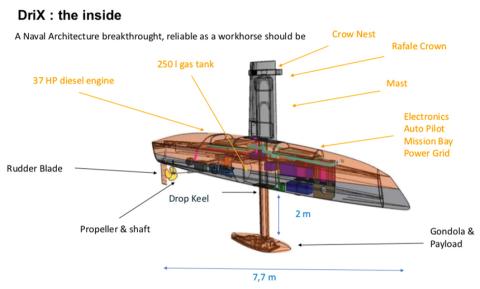
In a collaborative effort with Exail, NOAA, and the Center, DriX Autonomous Surface Vessels have been housed and supported by the Center since the December 2018. The DriX is a 7.7 m long, wave-piercing, composite composition vehicle, capable of meeting NOAA’s hydrographic survey specifications at speeds exceeding 10 knots. In addition, the DriX boasts an endurance of seven 24-hour days at 7 knots, providing a long-endurance capability not possible by most other vehicles of its size.
The Center facilitated the installation of an EM2040 multibeam system and a Kongsberg MBR long-range radio for vehicle evaluation and testing—both at the Center and in trials aboard NOAA vessels.
For additional information about the DriX, please contact Val Schmidt.


DriX is small enough to be towed on a trailer.

DriX in its LARS (launch and recovery system).

DriX and the NOAA Ship Thomas Jefferson in Norfolk, VA.

DriX is launched over the side of the NOAA Ship Thomas Jefferson.
DriX Specifications
Physical
- Length overall: 7.7 m
- Beam overall: 0.8 m
- Draft: 2.0 m
Propulsion
- Engine: 37 Hp Nanni Diesel
- Prop-driven
- Fuel capacity: 250 liters
- Endurance: ~400 nm (assumes 7 knots, leaving 15% fuel in reserve, and operating with the EM712 gondola)
- Top speed: >12 knots
Electrial
- 24V system
- 900 W for survey payload
Telemetry
- Kongsberg Marine Broadband Radio
- Wifi
- Starlink
- Iridium
Payload
- Kongsberg EM2040 or EM712
- iXblue PHINS AHRS with Septentrio GPS (LARS)
- EK-80 at 200kHz and 70kHz
- Sonardyne HPT3000 USBL
